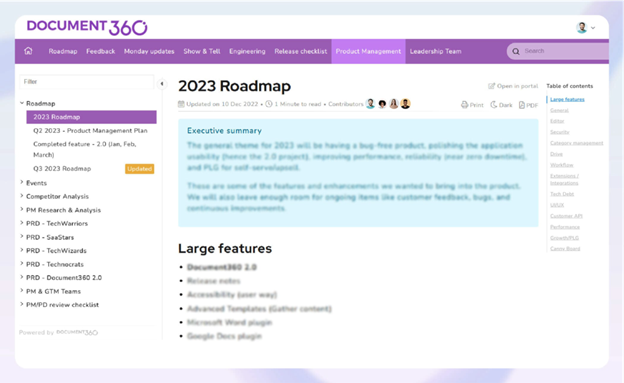When your team brainstorms ideas for upcoming product updates or even customer challenges, half never leave the table and reach the R&D team. Yet, it’s imperative to acknowledge that R&D isn’t the sole repository of wisdom. There are unsung heroes within your organization; their voices are muted in suggesting solutions despite their hands-on experience. Their invaluable knowledge is honed through countless real-world scenarios and cannot be gained with mere textbook learning. Regrettably, such insights often remain undocumented, eluding the radar of R&D teams.
Can you relate to such instances in your company? Consider the scenario when an employee bids farewell to the company, whether through retirement or other means; their tribal knowledge is lost forever.
To avoid the loss of such information, it is time you start documenting it.
To help you with documentation, we’ve created a quick guide that helps you understand the need and importance of tribal knowledge and ideas to document it. So, let’s dive!
What is Tribal Knowledge?
Tribal Knowledge refers to undocumented information not known by many in the organization. This information travels the office space through word-of-mouth and never reaches the right authorities to implement it.
Tribal knowledge isn’t like explicit knowledge, which is documented and shared with employees across departments. Unfortunately, it never leaves the employees’ minds or is brought up during crucial meetings.
Employees with tribal knowledge develop tactics over time that may help them achieve their personal work goals but may not benefit the team. This is one reason why employees must document tribal knowledge when they come across it to help others meet their goals, too.
In a nutshell, it is the untapped knowledge that remains unused or abused at an organization.
What Makes Tribal Knowledge Essential for Your Organization?
When people ask whether tribal knowledge is essential for your organization, the answer is undoubtedly a big yes.
That’s because tribal knowledge can result in:
- Better product upgrades
- Improved customer satisfaction
- Better company profits
Imagine these untapped ideas in the minds of one or probably two employees. What’s worse, they never make it to the team discussions. That means they remain undocumented until the employees leave the organization for a better career upgrade.
Real-world example: Have you heard of this funny Soap Cover Problem? If not, it’s good to hear it now. Once, there was a soap manufacturer who sent soaps to hotels regularly. But they got many customer complaints that some of the boxes were empty. So, it is time to improve the quality check process when the top management sits down to find a solution for this. Some from the engineering team suggested using lasers in the conveyor belt to detect the weight of soap and other high-tech solutions.
However, a low-level employee who works in the packaging department casually suggested having a fan blower near the conveyor belt to detect empty boxes. If the box is to be empty, it will fly. This is what we say about the wealth of knowledge from unsung heroes. They can provide better solutions with simple ideas.
Such advantages make it essential for companies to document tribal knowledge and distribute it to the right stakeholders.
5 Common Benefits of Tribal Knowledge
We know tribal knowledge can help you grow your company and simplify workflow if shared with team members. But that’s not the only benefit you may gain from it. This section explores some common benefits of sharing tribal knowledge that go unnoticed.
1. Enhanced efficiency and productivity
Tribal knowledge is mostly gained during the process of trial and error. When the team tests strategies or builds a product from scratch, they face multiple challenges. And while working through these challenges, they find a solution that yields the best results for the organization.
Once the solution is documented, other teams can find the same favorable solutions. They will execute the strategies efficiently or even build the product without missing deadlines. This is a great way to optimize employee efficiency and ensure they are always productive.
2. Preservation of organizational knowledge
Tribal knowledge is easy to lose track of during calls, meetings, or brainstorming sessions. However, once recorded, it can act as a manual for new employees. Preserving organizational knowledge helps streamline every process in the future, reducing the learning curve and bringing everyone on board with the current workflow.
3. Streamlined onboarding processes
Experienced employees have a lot to offer in terms of advice and how tasks should be completed for new hires. However, they may not remember everything during onboarding sessions and may miss out on pivotal information that may assist employees in doing their jobs better. That’s why documenting tribal knowledge will enable your organization to streamline the onboarding process and ensure all necessary information gets shared for better output.
4. Heightened decision-making and competitive advantage
Another benefit of documenting tribal knowledge is that it improves the decision-making process and allows for a competitive advantage in the market. Currently, every asset in your organization helps you make the right decisions that help you achieve your goals.
5. Fostering a collaborative company culture
When referring to tribal knowledge, it’s not just product knowledge that gets shared. Information like how certain tasks must be carried out, who to approach in case of emergency, how to approach team members who may already have a lot on their plates, and much more is also part of tribal knowledge.
How to Capture Tribal Knowledge Efficiently
With such amazing benefits, it becomes essential for your company to capture tribal knowledge. Here are a few tips to make it possible efficiently.
1. Define goals and prioritize knowledge to capture
When creating a tribal knowledge base for your company, you must set a few goals to help you define the information you want to capture.
For instance, you aim to capture all the information discussed during the product upgrade meetings. During these meetings, your team discusses:
- The downsides of the upgrade
- How this upgrade aims to help customers
- How to introduce the upgrade to the existing customers
- The training required for sales and marketing teams to bring in new customers
- How to use this upgrade to sell the product in the coming quarters
Let’s not forget the not-so-important suggestions made by each team member during the meeting. These must be added to the tribal knowledge base to capture information efficiently about a specific niche.
2. Identify key personnel holding tribal knowledge
Next, you need to identify the employee who holds the tribal knowledge. This could be the manager or a loyal employee who has been in the company for years. Here’s why we say so:
- Managers: Managers are involved in every brainstorming session and help the team prioritize the ideas. Moreover, employees who dislike sharing their ideas with everyone approach managers after the meeting adjourns. This way managers become one of the key personnel holding tribal knowledge.
- Employees: Those who have spent years in the organization know the best way to complete the work and ensure every milestone is achieved before the deadline. They may know which ideas the company will be open to accepting during meetings and which will not.
3. Create a knowledge management strategy
You now know the key holders of tribal knowledge and have decided what type of tribal knowledge needs to be documented. With these done, you need to develop your knowledge management strategy.
This strategy will enable you to capture the information faster, ease the documentation process, and make sharing hassle-free.
The idea behind the knowledge management strategy is to ensure that no information is lost even when an employee leaves the organization. Here’s what you need to keep in mind when implementing this strategy:
- Document every conversation through emails so that it is easier to track the tribal knowledge faster
- Be ready with employee replacements before they leave the organization
- Inculcate a practice of noting MOMs during meetings to ensure no ideas are left behind
4. Document tribal knowledge
To convert tribal knowledge into explicit knowledge, you must start documenting it in one place. When you do this, you get to identify the number of information categories you can create in your tribal knowledge base.
Understand that the information in the tribal knowledge base can help you create the following:
- Standard operating procedures document
- How-to-guides
- Training materials for sales or support teams
- Sales playbook
- Manuals
- Wikis
- FAQs
This way, you can help experienced employees share crucial information without asking them to plan and conduct separate training sessions for the entire team.
5. Establish a single source of truth
Since tribal knowledge spreads like myths through word-of-mouth, chances are that they end up creating knowledge silos. That’s because it is not written in one place but spoken and shared by employees during face-to-face chats.
It is better to establish a single source of truth for all to overcome such challenges. You can find cloud-based solutions that allow you to document and share knowledge internally with all employees. What’s more, this knowledge can be accessed and edited if needed.
6. Opt for appropriate knowledge management tools
Look for SaaS tools specializing in knowledge documentation. To narrow your options, search online for the best knowledge base software.
Or you can explore Document360, which can be your organization’s internal and external knowledge base system.
When it comes to being an internal documentation tool, Document360 allows you to:
- Share knowledge internally via secured login. That means only employees with login access can access the tribal knowledge.
- Collaborate with other employees while the tribal knowledge gets documented in real-time via in-line comments.
- Create a workflow that enables you to design and manage the entire documentation process from start to finish.
- Add links to other relevant articles in the same documentation.
- Add team roles to ensure only selected members can edit and publish articles from the team’s end.
- Restore deleted articles by creating their backup to ensure no tribal knowledge is lost.
- Use Enterprise SSO, where you use single sign-on to authenticate every user.
With such features, it will be easier to document and store tribal knowledge and ensure it gets shared internally.

Schedule a demo with one of our experts to take a deeper dive into Document360
Book A Demo
7. Cultivate an organizational learning culture
Once you document tribal knowledge in a single place, your next step is to prompt its use in the organization.
You can ask managers to share the documentation link with the team members and review it with them once. Let them know that they can access it anytime whenever they have doubts or need a solution to a certain problem at work.
Examples of Tribal Knowledge
We’ve understood that tribal knowledge is sourced through employee experience. Whether they are creating strategies to generate more leads for the business or upgrading the product for better performance, employees who have been a part of the organization for a long time will have a lot more tribal knowledge than we know.
Here are a few examples to help you understand the same.
- Developers: Those who have been associated with the business since the onset of their products know a product inside out. They know its limitations and possible ways to upgrade it. They know which integrations can make the product a lot stronger in terms of performance and which won’t. Their unmatched knowledge allows a business to create an achievable product roadmap.
- Marketers: From identifying the target ICPs to ensuring the best possible strategies to secure higher MQLs, experienced marketers will help you do it all. This is true, especially for those marketers who have seen the brand evolve and identified the USPs to create strategic marketing strategies.
- Sales: Experienced sales team members know when to propose leads to convert into customers. They also know which features can attract new customers because they know the product thoroughly.
- Support: This team is one of the best examples of how tribal knowledge has existed for years in the company, and nobody knows until they decide to share. They will know how to manage tough yet existing customers on calls. They will know who to approach to offer technical support to customers. Experienced support team members would also act as success managers because they take the initiative to check in with customers to know whether they are happy since their last support call.
These examples indicate the forms in which tribal knowledge exists in various teams. And, honestly, it shouldn’t be taken lightly.
Wrapping up
There is no doubt that tribal knowledge, even after various measures, is hard to catch up to. We say this because you cannot always monitor employees to see when this knowledge is shared in the workplace.
However, you can reach out to managers and ask them to help you collate this knowledge in one place. You can ask for their assistance when creating a tribal knowledge base for your company.
Once created, it becomes easier for employees who hesitate to share their ideas publicly. They, too, can contribute and share their ideas with the team. This way, you can ensure that tribal knowledge never leaves your company, even when employees do.




 –
– 

